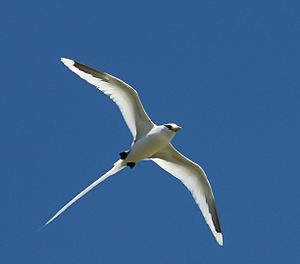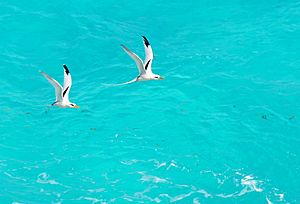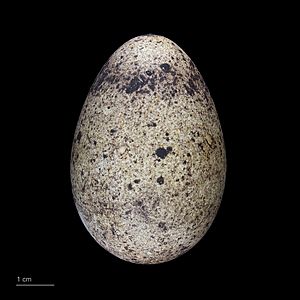White-tailed tropicbird facts for kids
Quick facts for kids White-tailed tropicbird |
|
|---|---|
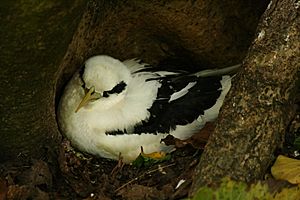 |
|
| Conservation status | |
| Scientific classification | |
| Genus: |
Phaethon
|
| Species: |
lepturus
|
 |
|
The white-tailed tropicbird (Phaethon lepturus) is a beautiful seabird that lives in warm, tropical oceans. It is the smallest of three types of tropicbirds. You can find it flying over the Atlantic, western Pacific, and Indian Oceans.
These birds also make their nests on some islands in the Caribbean. A few pairs have even started nesting on Little Tobago island. They join a group of red-billed tropicbirds there. In places like Bermuda, people sometimes call them "longtails" because of their very long tail feathers.
Contents
Different Types of White-tailed Tropicbirds
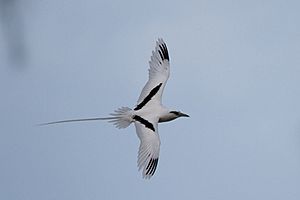
There are six slightly different kinds, or subspecies, of the white-tailed tropicbird. Each one lives in a specific part of the world:
- P. l. lepturus—Found in the Indian Ocean.
- P. l. fulvus (also called the golden bosun)—Lives on Christmas Island. These birds have a special golden color on their white feathers.
- P. l. dorotheae—Found in the tropical Pacific Ocean.
- P. l. catesbyi—Lives in Bermuda and the Caribbean.
- P. l. ascensionis—Found on Ascension Island.
- P. l. europae—Lives on Europa Island in the southern Mozambique Channel.
What Does a White-tailed Tropicbird Look Like?
Adult white-tailed tropicbirds are slim and mostly white. They are about 71 to 80 centimeters (28 to 31 inches) long. This measurement includes their very long central tail feathers, which can make the bird seem twice as long! Their wings can spread out to 89 to 96 centimeters (35 to 38 inches) wide.
These birds have a black band on the inside part of their wings. They also have a black mask around their eyes. Their bill, or beak, can be orange-yellow to orange-red. You can tell them apart from the red-billed tropicbird because of their bill color, their pure white back, and the black bar on their wings.
How Do White-tailed Tropicbirds Live?
White-tailed tropicbirds make their nests on tropical islands. They lay just one egg directly on the ground or on a cliff ledge. When they are not nesting, they fly widely across the oceans. Sometimes, they travel very far from their usual homes.
These birds eat mostly flying fish, squid, and crabs. They catch their food by diving into the water from as high as 20 meters (65 feet). This is similar to how gannets hunt. However, they can also catch flying fish right out of the air! They often hunt in pairs. After catching prey, they usually hover above the water to swallow it before flying off again.
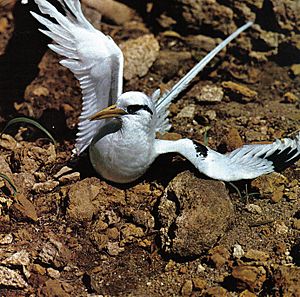
White-tailed tropicbirds are not very good swimmers. Their call sounds like a high-pitched scream: keee-keee-krrrt-krrt-krrt. Both male and female birds look similar, but males usually have longer tails. Young birds do not have the long tail feathers. They also have a green-yellow bill and fine stripes on their back.
These birds do not breed at the same time every year. Instead, they breed when the weather is good and there are suitable places to nest. They can breed again 10 months after a successful nesting, or 5 months after a nesting that did not work out.
Protecting These Birds
We don't know exactly how the number of white-tailed tropicbirds is changing. In Mexico, for example, they are not listed under any special protection. There are no specific programs just for them there. However, these birds are part of larger programs that protect American water birds. Experts suggest that we need to study these birds more when they are at sea. They also recommend keeping an eye on their nesting places. Around the world, the white-tailed tropicbird is considered a species of "Least Concern." This means they are not currently in danger of disappearing.
Old Stories About the Bird
The ancient Chamorro people from the Pacific islands had special names for the white-tailed tropicbird: utak or itak. They believed that if this bird screamed over a house, it meant someone would soon die. They also thought it could mean an unmarried girl was pregnant. They even believed that the bird's call could harm anyone who didn't believe in its power! Chamorro fishermen would watch these birds to find schools of fish in the ocean.
See also
 In Spanish: Rabijunco común para niños
In Spanish: Rabijunco común para niños



